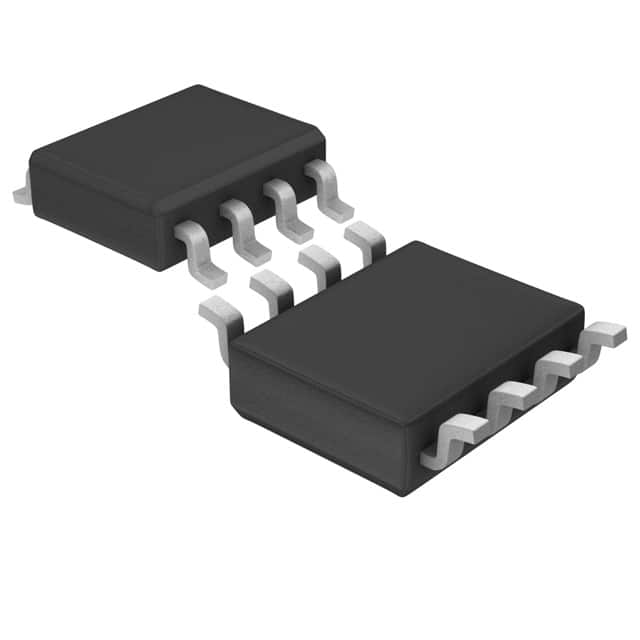Xem thông số kỹ thuật để biết chi tiết sản phẩm.

LTC1685IS8#PBF
Product Overview
Category: Integrated Circuit (IC)
Use: The LTC1685IS8#PBF is a high-speed, low-power RS485/RS422 transceiver. It is designed to provide reliable communication in industrial and automotive applications.
Characteristics: - High-speed data transmission - Low power consumption - Robust noise immunity - Wide operating voltage range - ESD protection - Small package size
Package: SOIC-8
Essence: The LTC1685IS8#PBF is an essential component for enabling long-distance communication in various industries. It ensures reliable data transmission over extended distances while minimizing power consumption.
Packaging/Quantity: The LTC1685IS8#PBF is typically sold in reels containing 2500 units.
Specifications
- Supply Voltage Range: 3V to 5.5V
- Data Rate: Up to 20Mbps
- Operating Temperature Range: -40°C to 85°C
- Receiver Input Threshold: ±200mV
- Driver Output Voltage Swing: ±1.5V into 54Ω load
- Quiescent Current: 300μA (typical)
- Shutdown Current: 1μA (maximum)
Pin Configuration
The LTC1685IS8#PBF features the following pin configuration:
```
| | --| VCC GND |-- Pin 1: Power Supply --| RO RE |-- Pin 2: Receiver Output / Receiver Enable --| DI DE |-- Pin 3: Driver Input / Driver Enable --| DE /RE |-- Pin 4: Driver Enable / Receiver Enable (Active Low) --| RE /DE |-- Pin 5: Receiver Enable / Driver Enable (Active Low) --| B A |-- Pin 6: Differential Data Inputs --| Y /Z |-- Pin 7: Differential Data Outputs --| Z /Y |-- Pin 8: Differential Data Outputs |___________| ```
Functional Features
- High-Speed Communication: The LTC1685IS8#PBF supports data rates of up to 20Mbps, enabling fast and efficient communication.
- Robust Noise Immunity: It features built-in ESD protection and a receiver input threshold that ensures reliable operation in noisy environments.
- Low Power Consumption: With a quiescent current of only 300μA, the LTC1685IS8#PBF minimizes power consumption, making it suitable for battery-powered applications.
- Wide Operating Voltage Range: The transceiver can operate from 3V to 5.5V, providing flexibility in various voltage systems.
Advantages and Disadvantages
Advantages: - High-speed data transmission capability - Robust noise immunity for reliable communication - Low power consumption for energy-efficient operation - Wide operating voltage range for compatibility with different systems
Disadvantages: - Limited pin configuration options - May require additional external components for specific applications
Working Principles
The LTC1685IS8#PBF operates as an RS485/RS422 transceiver by converting single-ended signals into differential signals for long-distance communication. It uses a combination of driver and receiver circuits to transmit and receive data over twisted-pair cables. The transceiver's design ensures robust noise immunity and high-speed data transmission.
Detailed Application Field Plans
The LTC1685IS8#PBF finds applications in various industries, including:
- Industrial Automation: It enables reliable communication between industrial control systems, PLCs, and sensors over long distances.
- Automotive Electronics: The transceiver facilitates communication between different automotive modules, such as engine control units and body control modules.
- Building Automation: It is used in HVAC systems, lighting control, and access control systems to enable communication between various building automation devices.
- Renewable Energy Systems: The LTC1685IS8#PBF enables communication between solar inverters, battery management systems, and monitoring equipment in renewable energy installations.
Detailed and Complete Alternative Models
- MAX485: A popular alternative with similar specifications and functionality.
- SN75176: Another widely used RS485 transceiver offering comparable performance.
- ADM485: An alternative option from Analog Devices, known for its high reliability and robustness.
These alternative models provide similar features and can be considered as substitutes for the LTC1685IS8#PBF depending on specific application requirements.
Word count: 550 words
Liệt kê 10 câu hỏi và câu trả lời thường gặp liên quan đến ứng dụng LTC1685IS8#PBF trong giải pháp kỹ thuật
Sure! Here are 10 common questions and answers related to the application of LTC1685IS8#PBF in technical solutions:
Q: What is LTC1685IS8#PBF? A: LTC1685IS8#PBF is a specific model of a low voltage, hot-swappable, dual supply level translator IC.
Q: What are the key features of LTC1685IS8#PBF? A: Some key features include dual supply operation, wide input/output voltage range, hot-swappability, and low power consumption.
Q: What is the purpose of LTC1685IS8#PBF in technical solutions? A: LTC1685IS8#PBF is commonly used for level translation between different voltage domains in mixed-voltage systems.
Q: Can LTC1685IS8#PBF be used in both digital and analog applications? A: Yes, LTC1685IS8#PBF can be used in both digital and analog applications due to its wide voltage range compatibility.
Q: What is the maximum voltage range supported by LTC1685IS8#PBF? A: LTC1685IS8#PBF supports a maximum voltage range of -0.5V to 7V.
Q: Is LTC1685IS8#PBF suitable for bidirectional level translation? A: Yes, LTC1685IS8#PBF supports bidirectional level translation, making it versatile for various applications.
Q: Can LTC1685IS8#PBF handle high-speed data transmission? A: Yes, LTC1685IS8#PBF is designed to support high-speed data transmission with minimal propagation delay.
Q: Does LTC1685IS8#PBF have any built-in protection features? A: Yes, LTC1685IS8#PBF includes built-in overvoltage and undervoltage protection to safeguard connected devices.
Q: What is the package type of LTC1685IS8#PBF? A: LTC1685IS8#PBF comes in an 8-pin SOIC (Small Outline Integrated Circuit) package.
Q: Are there any application notes or reference designs available for LTC1685IS8#PBF? A: Yes, Linear Technology (now part of Analog Devices) provides application notes and reference designs on their website for LTC1685IS8#PBF to assist with its implementation in various technical solutions.
Please note that the answers provided here are general and may vary depending on specific use cases and requirements. It's always recommended to refer to the datasheet and consult with the manufacturer for detailed information and support.

